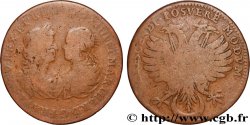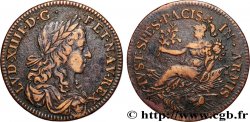E-auction 640-644677 - LOUIS XIV LE GRAND ou LE ROI SOLEIL Préliminaires de la Paix de Munster n.d.
Чтобы принять участие в торгах, вы должны войти в систему и стать подтвержденным участником аукциона. Войдите, чтобы сделать ставку. Ваш аккаунт будет подтвержден в течение 48 часов. Не ждите до закрытия торгов, чтобы зарегистрироваться.Сделав ставку на данный товар, вы вступаете в юридическое соглашение на покупку выбранного товара и нажатием кнопки «Сделать ставку» подтверждаете принятие вами условий интернет-аукционов cgb.fr.
Ставка может бить сделана только в полном эквиваленте евро. Торги закроются согласно времени, указанному в описании товара, все ставки, сделанные после закрытия торгов, учитываться не будут. Не следует откладывать предложение вашей ставки до последнего момента, так как система может не успеть обработать вашу заявку, и ваша ставка не будет принята. Более детальную информацию вы найдёте здесь: FAQ по интернет-аукционам.
БЕСПЛАТНО.
БЕСПЛАТНО.
2025/07/21 20:09:20
fjt_1042448
640
Вам необходимо авторизоваться, чтобы сделать ставку
Нажмите сюда, чтобы войти
Тип Préliminaires de la Paix de Munster
Дата: n.d.
Металл: brass
Диаметр: 24,50 mm
Ориентация осей монеты: 6 h.
Вес: 4,77 g.
Век: lisse
Пуансон: sans poinçon
Редкость: R1
Комментарии о состоянии
Patine hétérogène avec des traces d’usure, quelques coups et rayures. Taches d’oxydation et traces de nettoyage
Ссылки в каталоге: :
Лицевая сторона
Аверс: легенда: LVD. XIIII. D. G. FR. ET. NAV. REX.
Аверс: описание: Buste de Louis XIV, type Guéant Prieur 218L.
Обратная сторона
Реверс: легенда: IVSTIS. SPES. - PACIS. IN. ARMIS. .
Реверс: Описание: La Paix ou la France assise à gauche sur des armes, tenant une branche de laurier et une corne d'abondance.
Реверс: перевод: L'espoir de Paix repose sur les armes.
Комментарий
Suite au Traité de Munster, la France est confirmée dans la possession des Trois-Évêchés de Metz, Toul et Verdun annexés de fait depuis un siècle.
La maison d'Autriche lui cède tous les droits qu'elle possède sur l'Alsace, c'est-à-dire les landgraviats d'Alsace ;
Le Sundgau, comprenant : le comté de Ferrette ; les seigneuries dites médiatisées, à savoir : les seigneuries des Reinach (Montjoie et Hattstatt), des Ribeaupierre (Ribauvillé, Zellenberg, Guémar, Wihr-au-Val, Orbey, la moitié de Sainte-Marie-aux-Mines et Heiteren), de Bollwiller et d'Issenheim ; les terres dites engagées, à savoir : la seigneurie de Hohandsberg, des Schendi ; celle de Hokœnigsbourg et le val de Villé ; la place-forte de Brisach, sur la rive droite du Rhin, et ses dépendances : Hochstetten, Niederrimsingen, Hartheim et Achkarren ainsi que, sur la rive gauche, Biesheim ; Philippsburg ; les droits de bailli sur dix villes de l'empire en Alsace sans Strasbourg ni Mulhouse.
La France annexe la forteresse de Pignerol, dans le Piémont, et Moyenvic, en Lorraine.
De nombreux princes allemands conservent des fiefs en Alsace avant son rattachement à la France. Le traité stipule que leurs possessions ne dépendent pas du droit français mais de celui du Saint Empire romain germanique.
Avec le traité de Münster, la France atteint son but qui est d'agrandir durablement le royaume. L'empereur perd le droit de mener la politique extérieure de l'Empire. Celle-ci est désormais soumis à l'accord du Reichstag. Pour plus de précisions, voir https://fr.wikipedia.org/wiki/Trait%C3%A9_de_M%C3%BCnster.
Following the Treaty of Munster, France was confirmed in possession of the Three Bishoprics of Metz, Toul and Verdun, which had been annexed for a century..
The House of Austria cedes to him all the rights it possesses over Alsace, that is to say the landgraviates of Alsace; Sundgau, comprising: the county of Ferrette; the so-called mediatized lordships, namely: the lordships of Reinach (Montjoie and Hattstatt), Ribeaupierre (Ribauvillé, Zellenberg, Guémar, Wihr-au-Val, Orbey, half of Sainte-Marie-aux-Mines and Heiteren), Bollwiller and Issenheim; the so-called engaged lands, namely: the lordship of Hohandsberg, Schendi; that of Hokœnigsbourg and the Val de Villé; the stronghold of Brisach, on the right bank of the Rhine, and its dependencies: Hochstetten, Niederrimsingen, Hartheim and Achkarren as well as, on the left bank, Biesheim; Philippsburg; bailiff's rights over ten cities of the empire in Alsace without Strasbourg or Mulhouse.
France annexes the fortress of Pignerol, in Piedmont, and Moyenvic, in Lorraine.
Many German princes retained fiefs in Alsace before its annexation to France.. The treaty stipulates that their possessions are not subject to French law but to that of the Holy Roman Empire..
With the Treaty of Münster, France achieved its goal of permanently expanding the kingdom.. The Emperor loses the right to conduct the Empire's foreign policy. This is now subject to the approval of the Reichstag.. For more details, see https://fr. Wikipedia. org/wiki/Trait%C3%A9_de_M%C3%BCnster
La maison d'Autriche lui cède tous les droits qu'elle possède sur l'Alsace, c'est-à-dire les landgraviats d'Alsace ;
Le Sundgau, comprenant : le comté de Ferrette ; les seigneuries dites médiatisées, à savoir : les seigneuries des Reinach (Montjoie et Hattstatt), des Ribeaupierre (Ribauvillé, Zellenberg, Guémar, Wihr-au-Val, Orbey, la moitié de Sainte-Marie-aux-Mines et Heiteren), de Bollwiller et d'Issenheim ; les terres dites engagées, à savoir : la seigneurie de Hohandsberg, des Schendi ; celle de Hokœnigsbourg et le val de Villé ; la place-forte de Brisach, sur la rive droite du Rhin, et ses dépendances : Hochstetten, Niederrimsingen, Hartheim et Achkarren ainsi que, sur la rive gauche, Biesheim ; Philippsburg ; les droits de bailli sur dix villes de l'empire en Alsace sans Strasbourg ni Mulhouse.
La France annexe la forteresse de Pignerol, dans le Piémont, et Moyenvic, en Lorraine.
De nombreux princes allemands conservent des fiefs en Alsace avant son rattachement à la France. Le traité stipule que leurs possessions ne dépendent pas du droit français mais de celui du Saint Empire romain germanique.
Avec le traité de Münster, la France atteint son but qui est d'agrandir durablement le royaume. L'empereur perd le droit de mener la politique extérieure de l'Empire. Celle-ci est désormais soumis à l'accord du Reichstag. Pour plus de précisions, voir https://fr.wikipedia.org/wiki/Trait%C3%A9_de_M%C3%BCnster.
Following the Treaty of Munster, France was confirmed in possession of the Three Bishoprics of Metz, Toul and Verdun, which had been annexed for a century..
The House of Austria cedes to him all the rights it possesses over Alsace, that is to say the landgraviates of Alsace; Sundgau, comprising: the county of Ferrette; the so-called mediatized lordships, namely: the lordships of Reinach (Montjoie and Hattstatt), Ribeaupierre (Ribauvillé, Zellenberg, Guémar, Wihr-au-Val, Orbey, half of Sainte-Marie-aux-Mines and Heiteren), Bollwiller and Issenheim; the so-called engaged lands, namely: the lordship of Hohandsberg, Schendi; that of Hokœnigsbourg and the Val de Villé; the stronghold of Brisach, on the right bank of the Rhine, and its dependencies: Hochstetten, Niederrimsingen, Hartheim and Achkarren as well as, on the left bank, Biesheim; Philippsburg; bailiff's rights over ten cities of the empire in Alsace without Strasbourg or Mulhouse.
France annexes the fortress of Pignerol, in Piedmont, and Moyenvic, in Lorraine.
Many German princes retained fiefs in Alsace before its annexation to France.. The treaty stipulates that their possessions are not subject to French law but to that of the Holy Roman Empire..
With the Treaty of Münster, France achieved its goal of permanently expanding the kingdom.. The Emperor loses the right to conduct the Empire's foreign policy. This is now subject to the approval of the Reichstag.. For more details, see https://fr. Wikipedia. org/wiki/Trait%C3%A9_de_M%C3%BCnster








 Cообщить об ошибке
Cообщить об ошибке Распечатать страницу
Распечатать страницу Отправить мой выбор
Отправить мой выбор Задать вопрос
Задать вопрос Consign / sell
Consign / sell
 Информация
Информация















